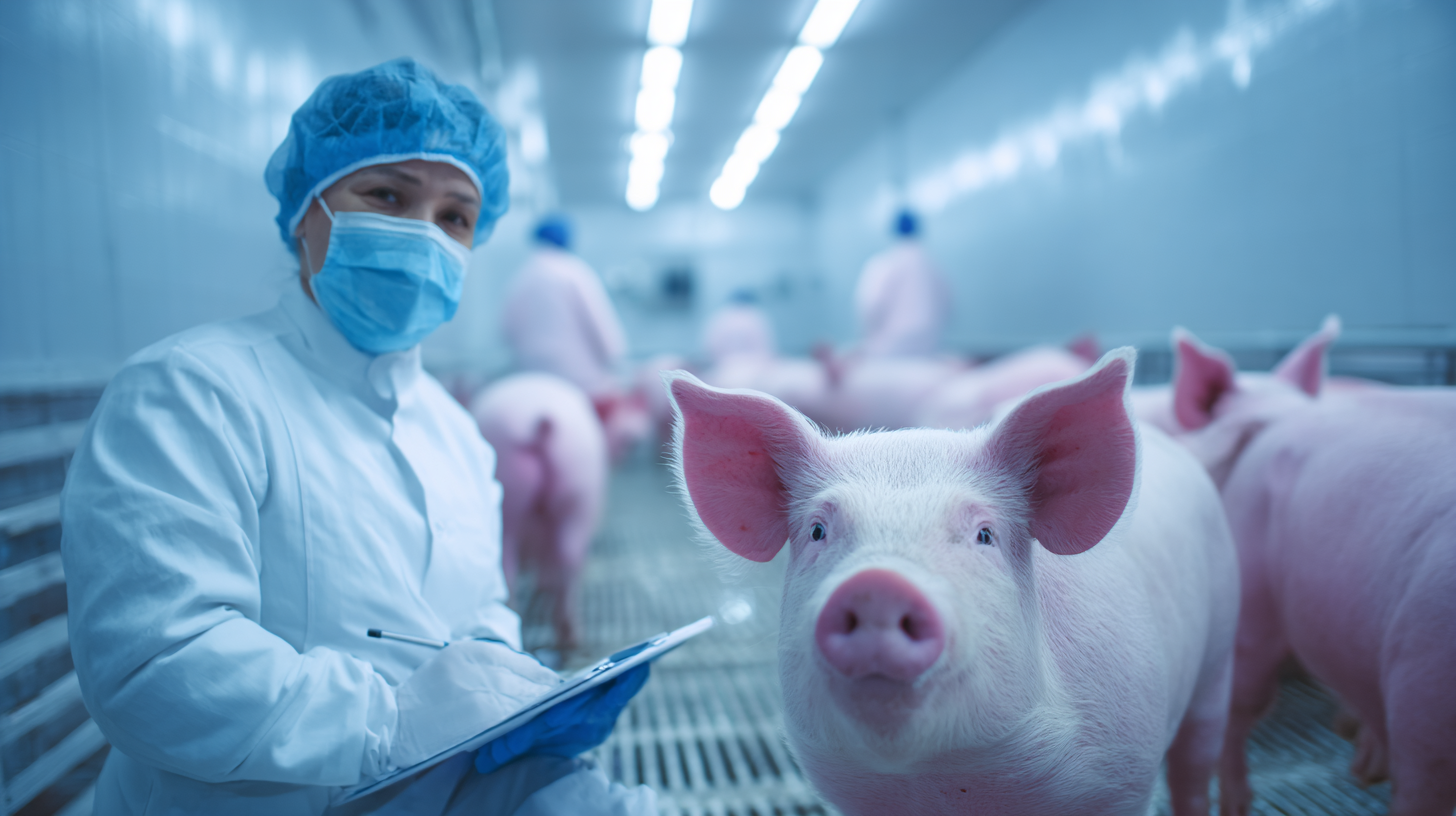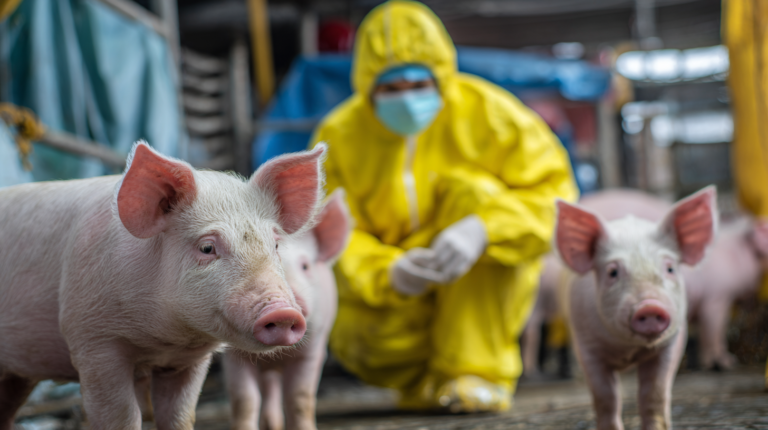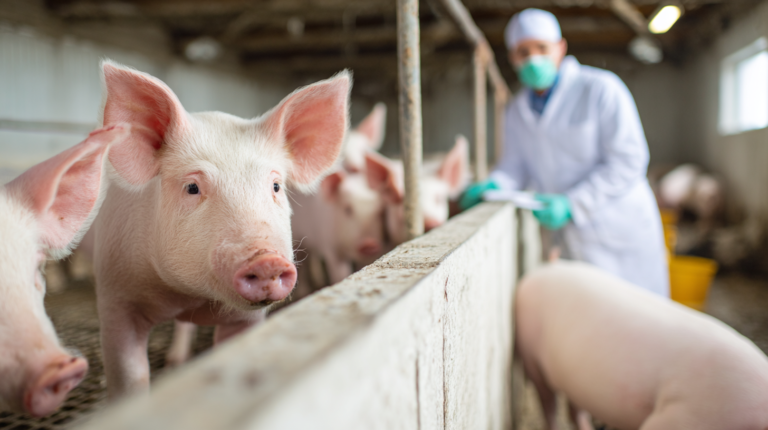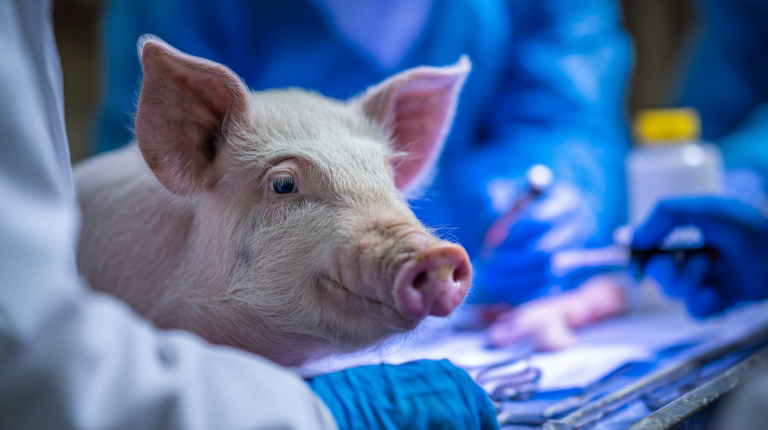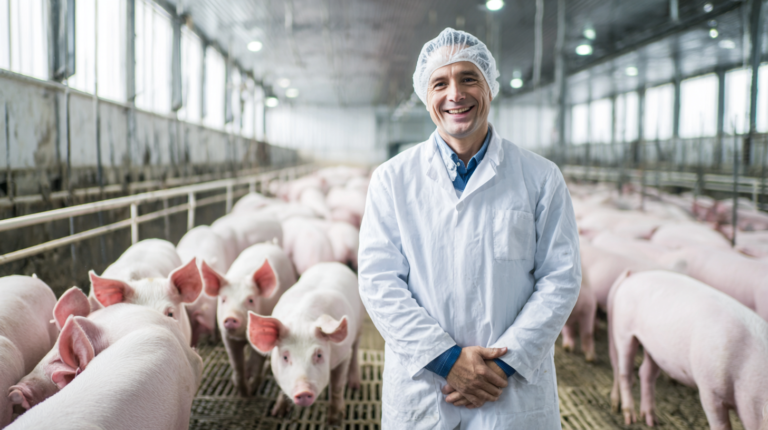Discover how to prevent bacterial infections in pigs with 6 essential veterinary-approved tips. Learn symptoms, treatments, and biosecurity measures for healthy swine.
Table of Contents
Bacterial infections in pigs represent one of the most significant health challenges facing swine producers, hobby farmers, and pet pig owners worldwide. These microscopic invaders can devastate entire herds, causing substantial economic losses and compromising animal welfare. Understanding how to prevent bacterial infections in pigs is crucial for maintaining healthy animals and sustainable farming operations.
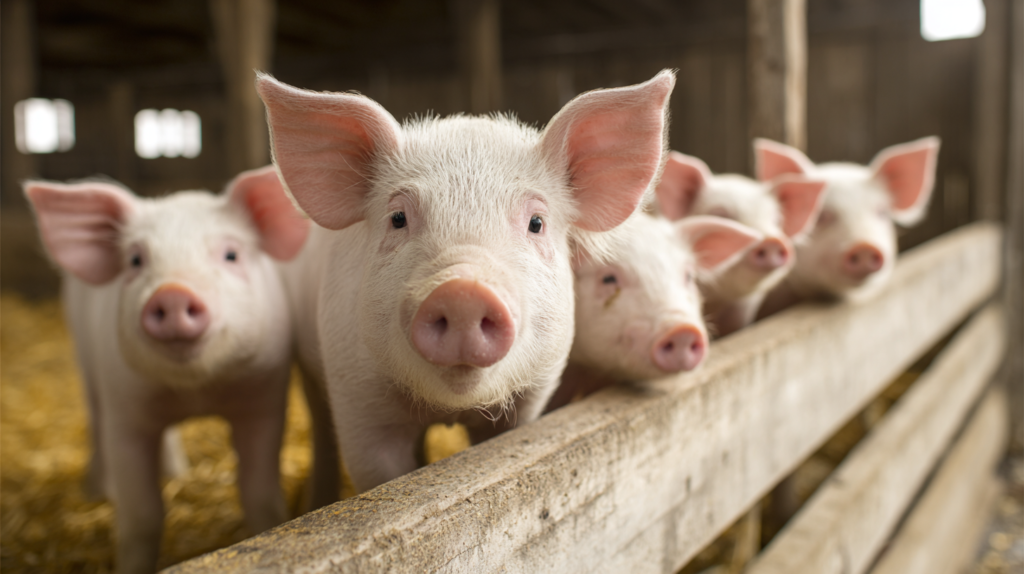
Recent studies from the American Veterinary Medical Association indicate that bacterial diseases account for approximately 35% of all swine health issues, with respiratory and digestive system infections being the most prevalent. The economic impact extends beyond immediate treatment costs, affecting growth rates, feed conversion efficiency, and overall productivity.
Whether you’re managing a commercial operation or caring for a beloved pet pig, implementing effective prevention strategies can mean the difference between thriving animals and costly health crises. This comprehensive guide explores evidence-based approaches to bacterial infection prevention, drawing from veterinary science and real-world experience to provide actionable insights for pig owners at every level.
Understanding Bacterial Infections in Pigs
| Bacterial Pathogen | Primary Symptoms | Affected System | Severity Level | Prevention Focus |
|---|---|---|---|---|
| Streptococcus suis | Meningitis, arthritis, septicemia | Nervous/Musculoskeletal | High | Biosecurity, vaccination |
| Escherichia coli | Diarrhea, dehydration, edema | Digestive | Moderate | Feed management, hygiene |
| Mycoplasma hyopneumoniae | Chronic cough, reduced growth | Respiratory | Moderate | Environmental control |
| Salmonella species | Enteritis, septicemia, fever | Digestive/Systemic | High | Feed safety, water quality |
| Actinobacillus pleuropneumoniae | Acute pneumonia, hemorrhage | Respiratory | High | Vaccination, air quality |
| Pasteurella multocida | Rhinitis, pneumonia, atrophy | Respiratory | Low-Moderate | Environmental management |
| Haemophilus parasuis | Polyserositis, arthritis, meningitis | Multiple systems | Moderate | Stress reduction, immunity |
Bacterial infections in pigs are caused by pathogenic microorganisms that invade the animal’s body systems, disrupting normal physiological functions. These infections can be primary, occurring when bacteria directly cause disease, or secondary, developing as complications from other conditions like viral infections or stress-related immunosuppression.
The most common bacterial pathogens affecting swine include Streptococcus suis, Escherichia coli, Pasteurella multocida, Haemophilus parasuis, and Mycoplasma hyopneumoniae. Each pathogen targets specific organ systems, with respiratory tract infections being particularly prevalent due to pigs’ sensitive respiratory anatomy.
Dr. Sarah Martinez, a board-certified veterinary microbiologist at the University of California Davis, explains: “Bacterial infections in pigs often present as complex, multi-system diseases. The key to effective prevention lies in understanding the specific risk factors and transmission pathways for each pathogen.”
Environmental factors play a crucial role in bacterial infection development. Poor ventilation, overcrowding, temperature fluctuations, and inadequate sanitation create ideal conditions for bacterial proliferation. Additionally, stress factors such as weaning, transportation, and dietary changes can compromise immune function, making pigs more susceptible to infection.
The pathophysiology of bacterial infections involves several stages: initial exposure, adhesion to host tissues, colonization, invasion, and systemic spread. Understanding this progression helps identify critical intervention points where prevention strategies can be most effective.
Common Types of Bacterial Infections
Respiratory Bacterial Infections
Respiratory bacterial infections represent the most frequent category of bacterial diseases in swine. Mycoplasma hyopneumoniae, the causative agent of enzootic pneumonia, affects up to 80% of commercial pig herds globally. This organism causes chronic respiratory disease characterized by persistent coughing, reduced growth rates, and increased susceptibility to secondary infections.
Pasteurella multocida is another significant respiratory pathogen, often associated with pneumonia and pleuritis. This bacteria typically causes acute respiratory distress, particularly in young pigs or those under stress. The organism can survive in the environment for extended periods, making biosecurity measures essential for prevention.
Haemophilus parasuis causes Glässer’s disease, a systemic infection that begins in the respiratory tract but can spread to cause meningitis, arthritis, and serositis. This condition is particularly devastating in nursery-age pigs, with mortality rates reaching 50% in severe outbreaks.
Digestive System Infections
Pathogenic Escherichia coli strains are primary causes of diarrheal diseases in pigs, particularly affecting neonates and recently weaned animals. Enterotoxigenic E. coli (ETEC) produces toxins that disrupt intestinal function, leading to severe dehydration and electrolyte imbalances.
Salmonella species, including S. Typhimurium and S. Choleraesuis, cause both acute and chronic digestive disorders. These bacteria can persist in the environment and pose significant public health risks through food chain contamination.
Lawsonia intracellularis, the causative agent of proliferative enteropathy, affects the small intestine and causes characteristic thickening of intestinal walls. This condition significantly impacts growth performance and feed efficiency in growing pigs.
Skin and Soft Tissue Infections
Streptococcus suis is a major cause of septicemia, meningitis, and arthritis in pigs. This organism can also cause skin infections, particularly around wounds or injection sites. The bacteria’s ability to form biofilms makes treatment challenging and prevention crucial.
Erysipelothrix rhusiopathiae causes swine erysipelas, a condition that can present as acute septicemia, chronic arthritis, or characteristic diamond-shaped skin lesions. This pathogen is particularly resilient in the environment and can survive in soil for months.
| Prevention Strategy | Key Implementation Steps | Target Pathogens | Priority Level | Expected Outcome |
|---|---|---|---|---|
| Tip 1: Comprehensive Biosecurity |
|
All bacterial pathogens | Critical | 90% reduction in pathogen introduction |
| Tip 2: Environmental Control |
|
Respiratory pathogens | Critical | 70% reduction in respiratory infections |
| Tip 3: Strategic Vaccination |
|
Specific targeted pathogens | High | 80% reduction in targeted diseases |
| Tip 4: Nutrition Optimization |
|
Digestive system pathogens | High | Enhanced immune response |
| Tip 5: Hygiene Protocols |
|
Environmental pathogens | Essential | 60% reduction in environmental load |
| Tip 6: Health Monitoring |
|
All bacterial infections | Essential | Early detection and treatment |
Essential Prevention Tip 1: Implement Comprehensive Biosecurity Measures
Effective biosecurity forms the cornerstone of bacterial infection prevention in pigs. This multi-layered approach involves controlling the movement of people, animals, vehicles, and equipment to minimize pathogen introduction and spread.
Physical Biosecurity Infrastructure
Establishing proper physical barriers is fundamental to biosecurity success. Perimeter fencing should completely surround the facility, with locked gates controlling access. Visitor parking areas should be located outside the perimeter, requiring all personnel to pass through designated entry points.
The design of entry protocols is critical. A well-designed entry system includes shower facilities, dedicated clean and dirty areas, and proper changing rooms. All personnel should shower in before entering production areas and shower out when leaving. This practice removes potential pathogens from skin and hair while preventing contamination of personal clothing.
Vehicle and Equipment Protocols
Vehicles represent significant pathogen transmission risks. Implement truck washing and disinfection protocols at designated areas away from animal housing. Use broad-spectrum disinfectants effective against bacterial pathogens, ensuring adequate contact time for pathogen inactivation.
Equipment sharing between facilities should be strictly controlled. When equipment movement is necessary, thorough cleaning and disinfection protocols must be followed. Consider maintaining facility-specific equipment to minimize cross-contamination risks.
Personnel Management
Human movement represents one of the highest-risk vectors for bacterial transmission. Establish clear protocols for personnel movement between different production areas. Implement the “all-in, all-out” principle where possible, ensuring complete depopulation and sanitization between groups.
Visitor protocols should be stringent, with mandatory quarantine periods for individuals who have been in contact with other swine operations. Maintain visitor logs and ensure all guests follow established biosecurity procedures without exception.
Feed and Water Security
Contaminated feed and water sources can introduce bacterial pathogens directly into pig populations. Source feed ingredients from reputable suppliers with documented quality control programs. Implement feed testing protocols to screen for bacterial contamination, particularly Salmonella species.
Water quality testing should be conducted regularly, with particular attention to bacterial counts and potential sources of contamination. Use appropriate water treatment systems, including chlorination or UV sterilization, to ensure microbiological safety.
Essential Prevention Tip 2: Maintain Optimal Environmental Conditions
Environmental management plays a crucial role in bacterial infection prevention by creating conditions that support pig health while inhibiting pathogen survival and transmission.
Temperature and Humidity Control
Pigs are highly sensitive to temperature fluctuations, which can stress the immune system and increase susceptibility to bacterial infections. Maintain consistent temperatures within the thermoneutral zone for each age group: newborns require 32-35°C (90-95°F), while finishing pigs are comfortable at 18-24°C (65-75°F).
Humidity levels should be maintained between 50-70% to optimize respiratory health. Low humidity can dry respiratory tract mucous membranes, reducing their protective function, while high humidity promotes bacterial growth and creates uncomfortable conditions for pigs.
Ventilation System Management
Proper ventilation is essential for maintaining air quality and reducing airborne bacterial transmission. Design ventilation systems to provide adequate air exchange rates while avoiding drafts that can stress animals. Minimum ventilation rates should be 0.35 cubic meters per minute per 50 kg of pig body weight.
Air filtration systems can significantly reduce airborne bacterial loads. High-efficiency particulate air (HEPA) filters are particularly effective against bacterial pathogens, though they require regular maintenance and replacement to maintain effectiveness.
Lighting and Photoperiod Management
Appropriate lighting programs support immune function and reduce stress-related susceptibility to bacterial infections. Provide 12-16 hours of light daily for growing pigs, with gradual transitions between light and dark periods to avoid sudden changes that can cause stress.
Flooring and Drainage Systems
Proper flooring design prevents moisture accumulation and bacterial growth. Slatted floors should have appropriate slot widths to allow waste removal while preventing injury. Solid floors require regular cleaning and disinfection to maintain sanitary conditions.
Effective drainage systems prevent water accumulation, which can become breeding grounds for bacterial pathogens. Ensure proper slope gradients and regular drain maintenance to prevent backup and contamination.
Essential Prevention Tip 3: Develop Strategic Vaccination Programs
Vaccination represents one of the most effective tools for preventing bacterial infections in pigs. A well-designed vaccination program should be developed in consultation with veterinary professionals and tailored to specific facility risks and pathogen profiles.
Core Vaccination Components
Primary bacterial vaccines for swine include those targeting Mycoplasma hyopneumoniae, Haemophilus parasuis, and Streptococcus suis. These vaccines should form the foundation of most vaccination programs due to the widespread nature and significant impact of these pathogens.
Mycoplasma hyopneumoniae vaccines are typically administered to piglets between 1-3 weeks of age, with booster doses given 2-3 weeks later. These vaccines significantly reduce the severity of enzootic pneumonia and improve overall respiratory health.
Timing and Administration Protocols
Vaccination timing is critical for optimal immune response development. Maternal antibodies can interfere with vaccine efficacy, so timing must balance protection needs with antibody interference. Work with veterinary professionals to develop age-appropriate vaccination schedules.
Proper vaccine storage and administration techniques are essential for maintaining vaccine potency. Store vaccines at recommended temperatures and use appropriate injection techniques to ensure effective immune stimulation. Rotate injection sites to prevent tissue damage and maintain vaccine efficacy.
Monitoring Vaccine Efficacy
Regular serological monitoring helps assess vaccination program effectiveness. Antibody titers can indicate whether vaccines are providing adequate protection levels. Adjust vaccination schedules based on monitoring results and changing pathogen pressures.
Customized Vaccination Strategies
Some facilities may benefit from autogenous vaccines developed from pathogens isolated from their specific pig populations. These vaccines can be particularly effective against farm-specific bacterial strains that may not be covered by commercial vaccines.
Consider seasonal vaccination adjustments based on pathogen pressure patterns. Some bacterial infections show seasonal variation, requiring modified vaccination schedules to provide optimal protection during high-risk periods.
Essential Prevention Tip 4: Optimize Nutrition and Feed Management
Proper nutrition plays a fundamental role in maintaining immune function and preventing bacterial infections in pigs. A well-balanced diet provides essential nutrients that support immune system development and function while avoiding nutritional deficiencies that can increase infection susceptibility.
Immune-Supporting Nutrients
Vitamin E and selenium work synergistically to support immune function and reduce oxidative stress. Deficiencies in these nutrients can significantly increase susceptibility to bacterial infections. Ensure adequate levels in all feed formulations, with particular attention to periods of stress or rapid growth.
Zinc is essential for proper immune function, with deficiencies leading to increased infection rates and slower wound healing. Organic zinc sources are often more bioavailable than inorganic forms, providing better support for immune function.
Vitamin A supports mucosal immunity in respiratory and digestive tracts, providing the first line of defense against bacterial pathogens. Ensure adequate vitamin A levels while avoiding toxicity from excessive supplementation.
Protein Quality and Amino Acid Balance
High-quality protein sources provide essential amino acids necessary for antibody production and immune cell function. Arginine, methionine, and lysine are particularly important for immune function and should be present in adequate quantities.
Digestible protein levels should be optimized for each production stage, with higher requirements during periods of rapid growth or stress. Poor protein quality can lead to increased nitrogen excretion, creating environmental conditions favorable to bacterial growth.
Feed Additives and Prebiotics
Organic acids, including formic acid, propionic acid, and benzoic acid, can help control bacterial growth in feed and the digestive tract. These additives create pH conditions unfavorable to pathogenic bacteria while supporting beneficial microbial populations.
Prebiotics, such as mannanoligosaccharides and fructooligosaccharides, support beneficial gut bacteria that compete with pathogenic organisms. These compounds can improve intestinal health and reduce the risk of digestive bacterial infections.
Essential oils and plant extracts have shown promise in supporting immune function and reducing bacterial pathogen loads. Compounds like oregano oil, thyme, and garlic extract have demonstrated antibacterial properties in research studies.
Feed Quality Control
Implement rigorous feed quality control programs to prevent bacterial contamination. Regular testing for Salmonella, E. coli, and other pathogenic bacteria helps ensure feed safety. Store feed in clean, dry conditions that prevent bacterial growth and contamination.
Mycotoxin testing is essential, as these compounds can suppress immune function and increase susceptibility to bacterial infections. Implement mycotoxin binders when necessary and source ingredients from suppliers with effective mycotoxin control programs.
Essential Prevention Tip 5: Establish Proper Hygiene and Sanitation Protocols
Effective hygiene and sanitation protocols are fundamental to preventing bacterial infections in pigs. These practices reduce pathogen loads in the environment and break transmission cycles that can lead to disease outbreaks.
Daily Cleaning Routines
Establish consistent daily cleaning schedules for all pig housing areas. Remove organic matter, including feces, urine, and feed residues, which can serve as growth media for bacterial pathogens. Use appropriate cleaning tools and techniques to avoid cross-contamination between areas.
Water systems require particular attention, as biofilm formation can harbor bacterial pathogens. Implement regular water line cleaning and disinfection protocols, with increased frequency during hot weather when bacterial growth rates are higher.
Disinfection Protocols
Select disinfectants based on their efficacy against target bacterial pathogens. Quaternary ammonium compounds are effective against many bacterial species, while phenolic compounds provide broad-spectrum activity. Ensure proper contact time and concentration for effective pathogen inactivation.
Rotation between different disinfectant classes helps prevent bacterial resistance development. Alternate between different chemical classes to maintain effectiveness over time. Monitor disinfectant efficacy through regular environmental sampling and bacterial culture.
All-In, All-Out Management
Implement all-in, all-out production systems where possible to break bacterial transmission cycles. This approach involves complete depopulation of housing areas followed by thorough cleaning and disinfection before introducing new animals.
During the empty period, allow adequate time for environmental drying, which helps eliminate many bacterial pathogens. Extended empty periods of 5-7 days provide additional pathogen reduction benefits.
Equipment Sanitization
Develop specific protocols for cleaning and disinfecting equipment used in pig care. This includes feeding equipment, handling tools, and medical supplies. Use dedicated equipment for different production areas to prevent cross-contamination.
Implement equipment washing and sanitization areas with appropriate drainage and disinfectant storage. Train personnel in proper equipment cleaning techniques to ensure consistent pathogen reduction.
Pest Control Integration
Rodents and insects can serve as vectors for bacterial pathogens, carrying organisms between areas and introducing new infections. Implement comprehensive pest control programs that include both prevention and active control measures.
Seal entry points, remove food sources, and maintain proper sanitation to reduce pest attraction. Use appropriate pest control products while considering their safety for pigs and personnel.
Essential Prevention Tip 6: Implement Health Monitoring and Early Detection Systems
Early detection of bacterial infections is crucial for preventing widespread outbreaks and minimizing their impact. Comprehensive health monitoring systems enable rapid identification of problems and prompt implementation of control measures.
Daily Health Observations
Train personnel to recognize early signs of bacterial infections in pigs. Key indicators include changes in appetite, respiratory rate, temperature, and behavior. Establish standardized observation protocols that ensure consistent monitoring across all production areas.
Respiratory signs often appear early in bacterial infections, including increased breathing rate, coughing, and nasal discharge. Digestive signs may include diarrhea, vomiting, and reduced feed consumption. Systemic signs include lethargy, fever, and reduced activity levels.
Temperature Monitoring Programs
Regular temperature monitoring can identify infections before clinical signs become apparent. Establish baseline temperature ranges for different age groups and production stages. Use appropriate thermometers and techniques to ensure accurate readings.
Automated monitoring systems can provide continuous temperature data, alerting personnel to significant changes that may indicate infection. These systems are particularly valuable for high-risk periods such as weaning or transportation.
Laboratory Testing Integration
Develop relationships with veterinary diagnostic laboratories to support rapid testing when infections are suspected. Keep appropriate sample collection supplies on hand and train personnel in proper collection techniques.
Regular surveillance testing can identify subclinical infections and monitor pathogen presence in the environment. This information helps guide prevention strategies and vaccination programs.
Record Keeping and Analysis
Maintain detailed health records that track infection patterns, treatment outcomes, and prevention program effectiveness. Use this data to identify trends and adjust management practices accordingly.
Analyze mortality and morbidity data to identify high-risk periods and areas for improvement. Share relevant information with veterinary professionals to support decision-making and program optimization.
Response Protocols
Develop clear protocols for responding to suspected bacterial infections. This includes isolation procedures, sampling protocols, and treatment guidelines. Ensure all personnel understand their roles and responsibilities during outbreak situations.
Establish communication systems for reporting health concerns and coordinating response efforts. Quick response can significantly reduce the impact of bacterial infections on pig health and production.
This comprehensive visual guide illustrates the key components of an effective biosecurity program:
Step 1: Perimeter Control – Establish secure fencing with controlled access points, visitor parking outside the production area, and clear signage indicating biosecurity requirements.
Step 2: Entry Protocols – Design shower-in facilities with separate clean and dirty areas, provide dedicated clothing and footwear, and implement visitor registration systems.
Step 3: Vehicle Management – Create designated vehicle washing areas, establish disinfection protocols, and control traffic flow to minimize contamination risks.
Step 4: Personnel Movement – Implement area-specific clothing changes, establish movement restrictions between production zones, and provide hand washing and sanitization stations.
Step 5: Equipment Control – Designate area-specific equipment, establish cleaning and disinfection protocols, and implement equipment tracking systems.
Step 6: Monitoring Systems – Install environmental monitoring equipment, establish health surveillance protocols, and implement record-keeping systems for tracking effectiveness.
Advanced Prevention Strategies
| Timeline Phase | Key Actions & Procedures | Diagnostic Methods | Timeframe | Success Indicators |
|---|---|---|---|---|
| Immediate Response 0-2 Hours |
|
Visual examination, temperature monitoring, behavioral assessment | Critical | Containment achieved, vet contacted |
| Diagnostic Phase 2-24 Hours |
|
Laboratory culture, PCR testing, serology, histopathology | Urgent | Pathogen identified, sensitivity determined |
| Treatment Initiation 24-48 Hours |
|
Clinical response monitoring, follow-up sampling | Urgent | Clinical improvement observed |
| Active Treatment 3-14 Days |
|
Daily clinical evaluation, weight monitoring, appetite assessment | Standard | Symptoms resolving, normal behavior returning |
| Recovery Monitoring 2-4 Weeks |
|
Follow-up cultures, serological testing, growth rate analysis | Standard | Full recovery, normal production metrics |
| Long-term Follow-up 1-3 Months |
|
Population health monitoring, environmental testing, surveillance cultures | Ongoing | No recurrence, improved herd immunity |
Molecular Diagnostics Integration
Modern molecular diagnostic tools enable rapid identification of bacterial pathogens and their antimicrobial resistance patterns. Polymerase chain reaction (PCR) testing can detect specific bacterial DNA within hours, compared to traditional culture methods that require days.
Real-time PCR systems allow for quantitative assessment of bacterial loads, helping determine infection severity and treatment urgency. These tools are particularly valuable for detecting fastidious organisms that are difficult to culture using traditional methods.
Precision Medicine Approaches
Genomic analysis of bacterial pathogens can identify specific virulence factors and resistance mechanisms, enabling targeted prevention strategies. This information helps optimize vaccine selection and guides antimicrobial stewardship programs.
Pharmacogenomics research is revealing how individual pig genetics influence drug metabolism and immune responses. This knowledge can inform personalized prevention and treatment approaches for different genetic lines.
Microbiome Management
Understanding the pig microbiome’s role in disease resistance is leading to new prevention strategies. Beneficial bacteria can outcompete pathogenic organisms for nutrients and attachment sites, reducing infection risk.
Probiotic supplementation with specific bacterial strains can enhance immune function and reduce pathogen colonization. Research is ongoing to identify optimal probiotic combinations for different production systems and age groups.
Environmental Monitoring Technologies
Internet of Things (IoT) sensors can continuously monitor environmental conditions that influence bacterial growth and transmission. These systems provide real-time data on temperature, humidity, air quality, and water parameters.
Automated alert systems can notify managers when conditions deviate from optimal ranges, enabling rapid corrective action. This technology is particularly valuable for maintaining consistent environmental conditions that support pig health.
Economic Impact and Cost-Benefit Analysis
The economic impact of bacterial infections in pigs extends far beyond immediate treatment costs. Production losses from reduced growth rates, increased mortality, and poor feed conversion can significantly impact profitability.
Recent industry data indicates that respiratory bacterial infections alone cost the swine industry approximately $2.5 billion annually in the United States. These costs include direct treatment expenses, reduced production efficiency, and increased labor requirements.
Prevention programs require initial investment but provide substantial returns through reduced disease costs and improved performance. A comprehensive prevention program typically costs $15-25 per pig but can prevent disease losses of $50-100 per pig during severe outbreaks.
The return on investment for prevention programs is typically 3:1 to 5:1, making them highly cost-effective compared to treatment-focused approaches. Additional benefits include improved animal welfare, reduced antimicrobial use, and enhanced consumer confidence in pork products.
Regulatory Considerations and Compliance
Bacterial infection prevention programs must comply with various regulatory requirements, including those related to antimicrobial use, animal welfare, and food safety. Understanding these requirements is essential for program development and implementation.
The Veterinary Feed Directive (VFD) in the United States requires veterinary oversight for medicated feed use, emphasizing the importance of prevention-focused approaches. Similar regulations in other countries are shifting toward reduced therapeutic antimicrobial use.
Hazard Analysis and Critical Control Points (HACCP) principles can be applied to bacterial infection prevention, identifying critical control points where interventions can prevent pathogen introduction or multiplication. This systematic approach helps ensure comprehensive coverage of risk factors.
Organic and antibiotic-free production systems place additional emphasis on prevention strategies, as therapeutic options are more limited. These systems often require more intensive management and monitoring to maintain animal health.
Frequently Asked Questions
For more expert pet care tips and product recommendations, visit BlithePet.com — your trusted source for pet wellness.
Conclusion
Preventing bacterial infections in pigs requires a comprehensive, multi-faceted approach that addresses all aspects of pig health and management. The six essential prevention tips outlined in this guide provide a framework for developing effective prevention programs that protect both animal health and production efficiency.
Successful prevention begins with understanding the complex relationships between pathogens, hosts, and environmental factors. By implementing robust biosecurity measures, optimizing environmental conditions, developing strategic vaccination programs, providing proper nutrition, maintaining excellent hygiene standards, and establishing effective health monitoring systems, pig owners can significantly reduce the risk of bacterial infections.
The investment in prevention programs pays dividends through improved animal health, reduced treatment costs, and enhanced production efficiency. As regulatory pressures continue to emphasize reduced antimicrobial use, prevention-focused approaches become increasingly important for sustainable pig production.
Remember that prevention programs require ongoing attention and adaptation based on changing conditions and emerging threats. Regular consultation with veterinary professionals, continuous monitoring of program effectiveness, and willingness to adjust strategies based on new information are essential for long-term success.
The future of pig health management lies in integrating traditional prevention principles with emerging technologies and scientific advances. By staying informed about new developments and maintaining commitment to comprehensive prevention programs, pig owners can ensure the health and productivity of their animals while contributing to sustainable agriculture practices.
Have a similar experience with your pet? Share it in the comments below!

